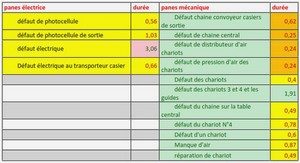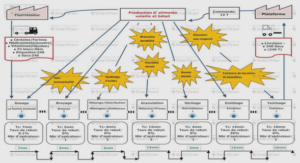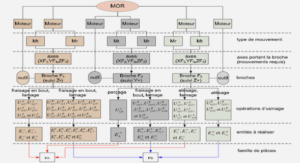HALF-SPACE IMPEDANCE LAPLACE PROBLEM
Direct scattering problem
Problem definition
We consider the direct scattering problem of linear time-harmonic surface waves on a perturbed half-space Ωe ⊂ R 3 +, where R 3 + = {(x1, x2, x3) ∈ R 3 : x3 > 0}, where the incident field uI is known, and where the time convention e −iωt is taken. The goal is to find the scattered field u as a solution to the Laplace equation in the exterior open and connected domain Ωe, satisfying an outgoing surface-wave radiation condition, and such that the total field uT , which is decomposed as uT = uI + u, satisfies a homogeneous impedance boundary condition on the regular boundary Γ = Γp∪Γ∞ (e.g., of class C 2 ). The exterior domain Ωe is composed by the half-space R 3 + with a compact perturbation near the origin that is contained in R 3 +, as shown in Figure 4.1. The perturbed boundary is denoted by Γp, while Γ∞ denotes the remaining unperturbed boundary of R 3 +, which extends towards infinity on every horizontal direction. The unit normal n is taken outwardly oriented of Ωe and the complementary domain is denoted by Ωc = R 3 \ Ωe.
Incident field
To determine the incident field uI , we study the solutions of the unperturbed and homogeneous wave propagation problem with neither a scattered field nor an associated radiation condition. The solutions are searched in particular to be physically admissible, i.e., solutions which do not explode exponentially in the propagation domain, depicted in Figure 4.2.The solutions uI of the problem (4.14) are given, up to an arbitrary scaling factor, by the progressive plane surface waves uI (x) = e iks·xs e −Z∞x3 , (ks · ks) = Z 2 ∞, xs = (x1, x2). (4.15) They correspond to progressive plane volume waves of the form e ik·x with a complex wave propagation vector k = (ks, iZ∞), where ks ∈ R 2 . It can be observed that these surface waves are guided along the half-space’s boundary, and decrease exponentially towards its interior, hence their name. They vanish completely for classical Dirichlet (Z∞ = ∞) or Neumann (Z∞ = 0) boundary conditions.
Green’s function
Problem definition
The Green’s function represents the response of the unperturbed system to a Dirac mass. It corresponds to a function G, which depends on the impedance Z∞, on a fixed source point x ∈ R 3 +, and on an observation point y ∈ R 3 +. The Green’s function is computed in the sense of distributions for the variable y in the half-space R 3 + by placing at the right-hand side of the Laplace equation a Dirac mass δx, centered at the point x. It is therefore a solution for the radiation problem of a point source, namely
Special cases
When the Green’s function problem (4.16) is solved using either homogeneous Dirichlet or Neumann boundary conditions, then its solution is found straightforwardly using the method of images (cf., e.g., Morse & Feshbach 1953). a) Homogeneous Dirichlet boundary condition We consider in the problem (4.16) the particular case of a homogeneous Dirichlet boundary condition, namely G(x, y) = 0, y ∈ {y3 = 0}, (4.18) which corresponds to the limit case when the impedance is infinite (Z∞ = ∞). In this case, the Green’s function G can be explicitly calculated using the method of images, since it has to be antisymmetric with respect to the plane {y3 = 0}. An additional image source point x¯ = (x1, x2, −x3), located on the lower half-space and associated with a negative Dirac mass, is placed for this purpose just opposite to the upper half-space’s source point x = (x1, x2, x3). The desired solution is then obtained by evaluating the full-space Green’s function (D.20) for each Dirac mass, which yields finally b) Homogeneous Neumann boundary condition We consider in the problem (4.16) the particular case of a homogeneous Neumann boundary condition, namely ∂G ∂ny (x, y) = 0, y ∈ {y3 = 0}, (4.20) which corresponds to the limit case when the impedance is zero (Z∞ = 0). As in the previous case, the method of images is again employed, but now the half-space Green’s function G has to be symmetric with respect to the plane {y3 = 0}. Therefore, an additional image source point x¯ = (x1, x2, −x3), located on the lower half-space, is placed just opposite to the upper half-space’s source point x = (x1, x2, x3), but now associated with a positive Dirac mass. The desired solution is then obtained by evaluating the full-space Green’s function (D.20) for each Dirac mass, which yields
Spectral Green’s function
a) Boundary-value problem To solve (4.16) in the general case, we use a modified partial Fourier transform on the horizontal (y1, y2)-plane, taking advantage of the fact that there is no horizontal variation in the geometry of the problem. To obtain the corresponding spectral Green’s function, we follow the same procedure as the one performed in Duran et al. (2005 ´ b). We define the forward Fourier transform of a function F
Spatial Green’s function
a) Spatial Green’s function as an inverse Fourier transform The desired spatial Green’s function is then given by the inverse Fourier transform of the spectral Green’s function (4.71) where the spherical coordinates (4.46) are used again inside the integrals. Due the linearity of the Fourier transform, the decomposition (4.72) applies also in the spatial domain, i.e., the spatial Green’s function is decomposed in the same manner by G = G∞ + GN + GL + GR.





